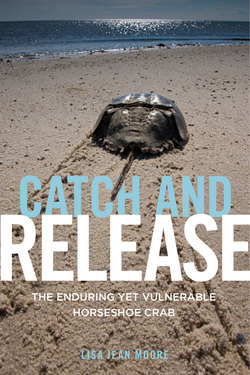Читать книгу Catch and Release - Lisa Jean Moore - Страница 8
На сайте Литреса книга снята с продажи.
ОглавлениеACKNOWLEDGMENTS
This research has been supported through the generosity of grants from Purchase College through a Doris and Carl Kempner Award and State University of New York Faculty Support Awards. Additionally, the Third International Workshop on the Science and Conservation of Horseshoe Crabs provided supplemental funding to attend the meetings in Sasebo, Japan, in June 2015. My union, the United University Professors, also supported my fieldwork through Joint Labor-Management Committee grants. Suzanne Kessler, dean of Natural and Social Sciences; Linda Bastone, chair of Natural and Social Sciences; and Chrys Ingraham, coordinator of Sociology, made my scholarly endeavors more achievable.
This work could not have happened without the patience, brilliance, and dedication of several environmental and natural scientists. One of the most rewarding benefits of extended fieldwork is getting to know people I would not ordinarily meet. Mark Botton has been a thoughtful, generous, and compassionate teacher and guide through the global horseshoe crab universe. He has also read every word of this book and greatly improved it. Smart, innovative, and committed scientists constantly inspire me; the immense wisdom they have imparted to me to me is deeply appreciated—most especially from Jennifer Mattei, Christina Colon, Jane Brockmann, Mary Hart, Ron Berzofsky, Dave Smith, Tom Novitsky, and Yumiko Iwasaki. John Tanacredi and Sixto Portillo welcomed me for a visit to their Center for Environmental Research and Coastal Oceans Monitoring at Molloy College in Long Island. Special thanks to Jane Brockmann and Tom Novitsky for offering close readings of chapters and their scientific expertise.
I am most grateful to my intrepid writing group. Jill Weiss, Megan Davidson, Andrea Long Chu, and C. Ray Borck have each contributed to my confidence as a writer and my ability to make my ideas meaningful across disciplinary divides. A lawyer, a doula, a feminist philosopher, and a sociologist make a good team. I am so lucky to have been able to work with this group of humans, and I look forward to continuing sharing of our very different but intertwined projects every other week. Extra gratitude goes to C. Ray for the beautiful hand-drawn and painted illustrations.
I am also fortunate to have many magnificent colleagues at Purchase College and beyond. Jason Pine has never failed to talk me off the ledge and remind me why this work is important; he makes me a better thinker. I’m so glad to continue conversations beyond our intellectual collaborations with the whip-smart Mary Kosut. Shaka McGlotten has an uncanny ability to say precisely the right thing at the right time. Jan Factor and George Kraemer both provided introductions and access to their scientific colleagues and vouched for me as I entered the field. Matthew Immergut, Alexis Silver, Liza Steele, Chrys Ingraham, and Kristen Karlberg make me happy to be a sociologist at Purchase College. Each has added to the strength of my analysis. In particular, Alexis Silver gave cogent feedback at a critical juncture. For skillful library magic and speedy responses, I thank the invaluable Darcy Gervasio. Monica Casper, my longtime collaborator and dear friend, enriches my life—both professionally and personally. My critical animal studies colleagues and students John Hartigan, Eben Kirksey, Liz Cherry, Anna Krol, Kyle Moran, and Jeffrey Mathias help me work through the pesky persistence of humanism. Mal Blum and Leah Wellbaum provided musical assistance. The Animals and Society Section of the American Sociological Association has been an intellectual home to me for the last few years, and I am grateful for the connections I have made.
I am blessed to have the most remarkable network of human friends, in particular Patty Howells, who originally suggested this project and has lovingly read every word, and Patti Curtis, my dearest friend and soulmate. I’ve dedicated this book to these two Patricias. I’ve also been blessed with Mira Handman, my pillow-talk companion; Pat Evans, who cheered me on at a particularly tricky spot; and Robyn Mierzwa, who collaborates on two very special lifelong projects. Sally Rappeport, Tine Pahl, and Shari Colburn have all offered perfectly timed support to me throughout this project. In a moment of anxiety during revisions, Laura Brahm generously read sections of the work.
I have worked for over a decade with New York University Press, publishing several books under the intelligence and grace of Ilene Kalish. Again and again I return to Ilene’s advice, “Good writing is rewriting.” Special thanks to Caelyn Cobb for editorial assistance.
Finally, I’d like to thank my family. When I fell down the stairs with an open computer, my brother-in-law Kel Currah didn’t judge me; he just went out and bought me a new one. My aunt, Joan Pendergast, is my fairy godmother with no compare. My parents, Linda and Richard Moore, are responsible for introducing me to horseshoe crabs and making sure I had access to them every single summer of my childhood and beyond. My daughters are my unqualified joy: Grace helped me think through some of the more scientific complexities of this book, Georgia enthusiastically participated in muddy fieldwork, and Greta cheerfully pointed out horseshoe crabs in any possible location. My husband, Paisley Currah, understands me like no other. Once, during a particularly difficult moment of self-recrimination, Paisley reassured me, “No, you aren’t terrible, you’re just human.” Like a mantra, I return to that phrase over and over again. It reassures me, makes me remember my own species being and my connection to all flawed others. It is important to remember I am just human, and it is amazing to remember I am a human being connected to his human being.
